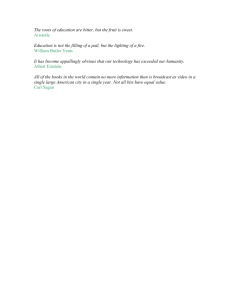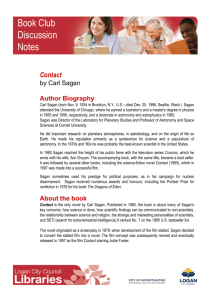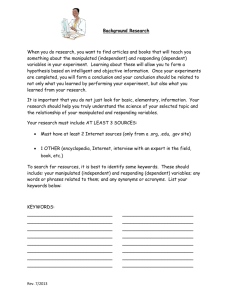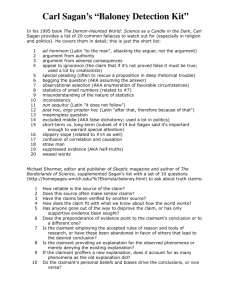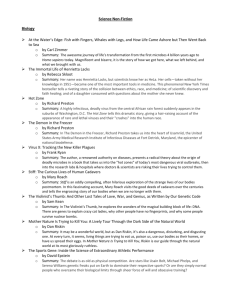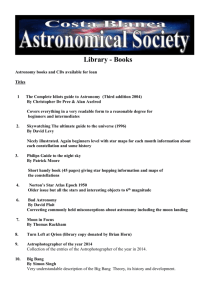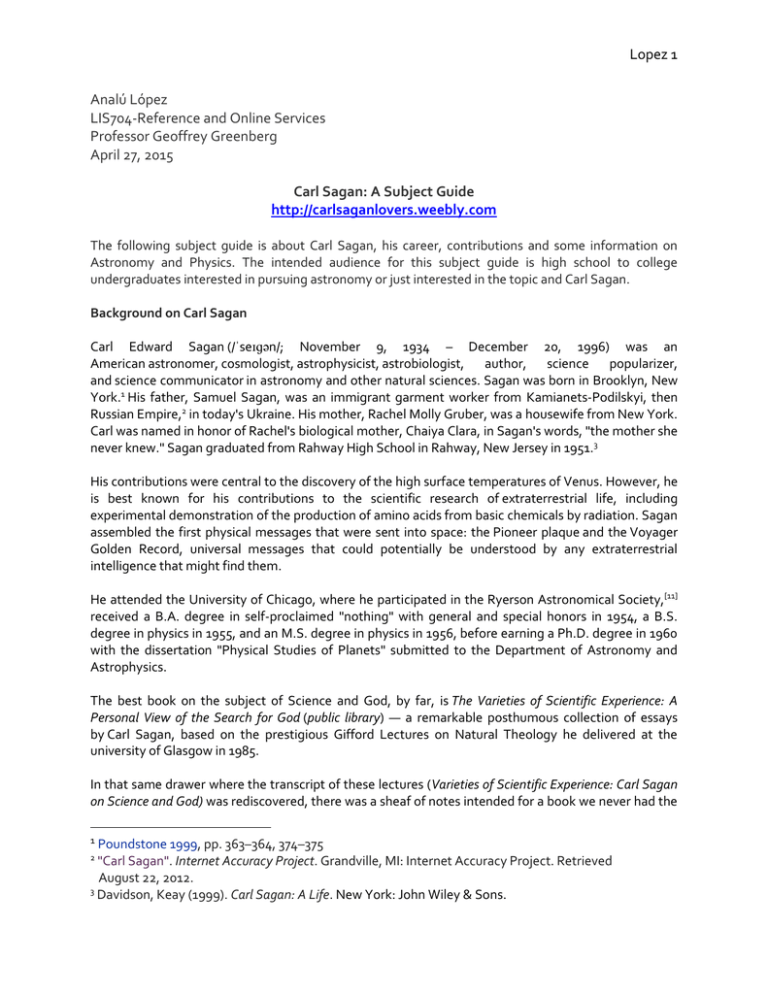
Lopez 1
Analú López
LIS704-Reference and Online Services
Professor Geoffrey Greenberg
April 27, 2015
Carl Sagan: A Subject Guide
http://carlsaganlovers.weebly.com
The following subject guide is about Carl Sagan, his career, contributions and some information on
Astronomy and Physics. The intended audience for this subject guide is high school to college
undergraduates interested in pursuing astronomy or just interested in the topic and Carl Sagan.
Background on Carl Sagan
Carl Edward Sagan (/ˈseɪɡən/; November 9, 1934 – December 20, 1996) was an
American astronomer, cosmologist, astrophysicist, astrobiologist, author, science popularizer,
and science communicator in astronomy and other natural sciences. Sagan was born in Brooklyn, New
York.1 His father, Samuel Sagan, was an immigrant garment worker from Kamianets-Podilskyi, then
Russian Empire,2 in today's Ukraine. His mother, Rachel Molly Gruber, was a housewife from New York.
Carl was named in honor of Rachel's biological mother, Chaiya Clara, in Sagan's words, "the mother she
never knew." Sagan graduated from Rahway High School in Rahway, New Jersey in 1951.3
His contributions were central to the discovery of the high surface temperatures of Venus. However, he
is best known for his contributions to the scientific research of extraterrestrial life, including
experimental demonstration of the production of amino acids from basic chemicals by radiation. Sagan
assembled the first physical messages that were sent into space: the Pioneer plaque and the Voyager
Golden Record, universal messages that could potentially be understood by any extraterrestrial
intelligence that might find them.
He attended the University of Chicago, where he participated in the Ryerson Astronomical Society,[11]
received a B.A. degree in self-proclaimed "nothing" with general and special honors in 1954, a B.S.
degree in physics in 1955, and an M.S. degree in physics in 1956, before earning a Ph.D. degree in 1960
with the dissertation "Physical Studies of Planets" submitted to the Department of Astronomy and
Astrophysics.
The best book on the subject of Science and God, by far, is The Varieties of Scientific Experience: A
Personal View of the Search for God (public library) — a remarkable posthumous collection of essays
by Carl Sagan, based on the prestigious Gifford Lectures on Natural Theology he delivered at the
university of Glasgow in 1985.
In that same drawer where the transcript of these lectures (Varieties of Scientific Experience: Carl Sagan
on Science and God) was rediscovered, there was a sheaf of notes intended for a book we never had the
1 Poundstone 1999, pp. 363–364, 374–375
2
"Carl Sagan". Internet Accuracy Project. Grandville, MI: Internet Accuracy Project. Retrieved
August 22, 2012.
3
Davidson, Keay (1999). Carl Sagan: A Life. New York: John Wiley & Sons.
Lopez 2
chance to write. Its working title was Ethos, and it would have been our attempt to synthesize the
spiritual perspectives we derived from the revelations of science. We collected filing cabinets’ worth of
notes and references on the subject. Among them was a quotation Carl had excerpted from Gottfried
Wilhelm Leibniz (1646–1716), the mathematical and philosophical genius, who had invented differential
and integral calculus independently of Isaac Newton. Leibniz argued that God should be the wall that
stopped all further questioning, as he famously wrote in this passage from Principles of Nature and
Grace:
“Why does something exist rather than nothing? For ‘nothing’ is simpler than ‘something.’ Now this
sufficient reason for the existence of the universe…which has no need of any other reason…must be a
necessary being, else we should not have a sufficient reason with which we could stop.”
And just beneath the typed quote, three small handwritten words in red pen, a message from Carl to
Leibniz and to us:
“So don’t stop.
CIRCULATING BOOKS: Required: 8 -10 annotated
1. Sagan, Carl. Pale Blue Dot: A Vision of the Human Future in Space. New York: Random
House, 1994. Print. pp. 384
Summary:
Sagan's great appeal as a popular-science writer, beyond his prodigious
knowledge, is his optimism and sense of wonder. A visualizer and a visionary, he
fires our imagination and turns science into high drama. After writing about our
origins in Shadows of Forgotten Ancestors (1992), Sagan turns his attention to
outer space and takes up where Cosmos left off 14 years ago.
An astonishing amount of information was amassed during that productive era,
and Sagan, of course, is up on all of it. A passionate and eloquent advocate of
space exploration, he believes that the urge to wander, and the need for a
frontier, is intrinsic to our nature, and that this trait is linked to our survival as a
species.
Throughout this beautifully illustrated, revelatory, and compelling volume,
Sagan returns again and again to our need for journeys and quests as well as our
unending curiosity about our place in the universe. Such philosophical musings
are interwoven with precise and enthusiastic accounts of the triumphs of
interplanetary exploration, from the Apollo moon landings to the spectacular
findings of robotic missions, especially the Voyager spacecraft. Sagan describes
one exciting discovery after another regarding the four giants--Jupiter, Saturn,
Uranus, and Neptune--and their many moons, mysterious and exquisite rings,
and volatile atmospheres. He argues, convincingly, that planetary exploration is
of immense value. It not only teaches us about our celestial neighbors, but helps
us understand and protect Earth. Yes, we have seemingly insurmountable
problems on this pale blue dot, but we have always reached for the stars, and
we mustn't stop now. Donna Seaman --This text refers to an out of print or
unavailable edition of this title.
Lopez 3
2. Davidson, Keay. Carl Sagan: A Life. New York: J. Wiley, c1999. Print. pp. 54o
Summary:
Carl Sagan was one of the most celebrated scientists of this
century-the handsome and alluring visionary who inspired a
generation to look to the heavens and beyond. His life was
both an intellectual feast and an emotional rollercoaster.
Based on interviews with Sagan's family and friends,
including his widow, Ann Druyan; his first wife, acclaimed
scientist Lynn Margulis; and his three sons, as well as
exclusive access to many personal papers, this highly
acclaimed life story offers remarkable insight into one of the
most influential, provocative, and beloved figures of our
time-a complex, contradictory prophet of the Space Age.
In a superbly researched biography of one of the 20the
century's most influential yet controversial scientists,
Davidson (coauthor, Wrinkles in Time) leaves no doubt about
where he feels his subject stands. "What is a visionary?" he
asks in the closing chapter.
"Carl Sagan measured time in eons and space in light years;
he maintained an interplanetary perspective." Though many
of Davidson's anecdotes echo those in William Poundstone's
Carl Sagan: A Life in the Cosmos, he actively guides readers to
conclusions, where Poundstone merely lays out the facts.
Though not avoiding Sagan's many failings as a person,
Davidson never allows his readers to lose sight of the grand
visions, brilliant insights and brash speculations that inspired
and educated Sagan's audiences. The book is at its strongest
when it shows the inner Sagan through his most influential
works: the Pulitzer Prize-winning Dragons of Eden; the Emmy
and Peabody Award-winning television series Cosmos; his SF
novel Contact; and his scientific publications about the
runaway greenhouse effect on Venus, the windblown dust
responsible for "waves of darkening" on Mars and the threat
of "nuclear winter" after a limited nuclear war on earth. The
volume is weakest when, instead of holding Sagan
responsible for his sometimes, arrogant behavior, it offers
excuses from pop psychology. Though nonscientific readers
may find Davidson's biography sufficient, naturally skeptical
scientific readers may find its conclusions too firm for
comfort. They should read Poundstone first, then turn to
Davidson to complete the picture. (Sept.) (c) Copyright
PWxyz, LLC. All rights reserved
Lopez 4
3. Poundstone, William. A Life in the Cosmos. New York: Henry Holt, c1999. Print. pp473.
Summary:
The first biography of the best-known scientist of his
generation and the author of the best-seller Cosmos. In this,
the first full-scale examination of the life of Carl Sagan, awardwinning science writer William Poundstone details the
transformation of a bookish young astronomer obsessed with
life on other worlds into science's first authentic media
superstar. As a fixture on television and a bestselling author,
Sagan became instantly recognizable. To people around the
world, he offered entrée into the mysteries of the cosmos and
of science in general. To much of the scientific
community,though, he was something of a pariah, a brazen
publicity seeker who cared more about his image and his
fortune than the advancement of science. Poundstone reveals
the seldom-discussed aspects of Sagan's life, the legitimate
and important work of his early scientific career, the almost
obsessive capacity to take on less projects, the multiple
marriages and fractured tumultuous personal life-all essential
elements of this complicated and extraordinary man, truly the
first and most famous scientist of the media age.
4. Sagan, Carl. The Varieties of Scientific Experience: A Personal view of the Search for God.
New York: Penguin Press, 2006. Print. pp. 284.
Summary:
This work is a posthumous edition of noted scientist Carl Sagan's Gifford
Lectures, given in 1985 at the University of Glasgow to mark the lectureship's
centennial. The title, provided by his widow and longtime collaborator Ann
Druyan, intends to call to mind another famous Gifford Lecture series by
philosopher William James, later published as the classic The Varieties of
Religious Experience. The title shift is both significant and suggestive. The
lecture topics range widely over the field of religion and science; Sagan sketches
the origins of modern science, the issues within the intelligent design debate,
the evolutionary and organic aspects of the solar system, the myths and
possibilities of extraterrestrial life, and the nature of God and human religious
experience. Not unexpectedly, Sagan espouses a definite viewpoint here, with
empirical science (a kind of "informed worship" for Sagan) clearly in the driver's
seat. Religious perspectives ride in the back, rather than alongside in the front
passenger seat helping to navigate the journey through the cosmos. But at least
Sagan acknowledges both are making the same journey.
For those willing to accept Sagan's premise, this is a clear, straightforward
introduction to the subject.
Summing Up: Recommended. All levels. C. S. Langton Principia College
Lopez 5
5. Frazier, Kendrick. Science Under Siege: Defending Science, Exposing Pseudoscience.
Amherst, N.Y.: Prometheus Books, 2009. Print. pp. 370.
Summary:
For more than thirty years, The Skeptical Inquirer has
steadfastly championed science and reason and been the
leading voice for reliable scientific examination of the
paranormal and other questionable claims popularized by
the media and mass culture. In this new collection of
outstanding recent articles, editor Kendrick Frazier has
selected some of the best writing on topics of current
interest. Among the highlights are: "A Skeptical Look at
September 11th" which prompted a drove of responses
(many angry) and was selected by Richard Dawkins for the
Best Science and Nature Writing of 2003. Carl Sagan's
final question-and-answer piece on the topic of science
and skeptical inquiry. Ann Druyan's beautifully expressed
"Science, Religion, Wonder, and Awe." NASA scientist
Stuart Jordan's excellent appraisal of the scientific
evidence for global warming, which prompted much
critical response and led to another follow-up article. Five
articles on the evolution vs. intelligent design controversy
Two physicians' articles that strongly defend the value of
vaccinations and critique the anti-vaccination movement
Other distinguished contributors include Mario Bunge,
Martin Gardner, Ray Hyman, Paul Kurtz, Chris Mooney,
Joe Nickell, Stephen Pinker, and many others. This
excellent collection of stimulating articles exploring
science and skeptical inquiry, public controversies, and
investigating pseudoscientific claims is a must for
scientists, educators, skeptics, and everyone concerned
about scientific literacy.
Lopez 6
6. Petersen, Carolyn Collins. Astronomy 101: From the Sun and Moon to Wormholes and
Warp Drive, Key Theories, Discoveries, and Facts About the Universe. Avon,
Massachusetts: Adams Media, 2013. Print. pp. 288.
Summary:
Explore the curiosities of our galaxy! Too often,
textbooks obscure the beauty and wonder of outer
space with tedious discourse that even Galileo
would oppose. Astronomy 101 cuts out the boring
details and lengthy explanations, and instead, gives
you a lesson in astronomy that keeps you engaged
as you discover what's hidden beyond our starry
sky. From the Big Bang and nebulae to the Milky
Way and Sir Isaac Newton, this celestial primer is
packed with hundreds of entertaining astronomy
facts, charts, and photographs you won't be able to
get anywhere else. So whether you're looking to
unravel the mystery behind black holes, or just want
to learn more about your favorite planets,
Astronomy 101 has all the answers--even the ones
you didn't know you were looking for.
7. Dean, Cornelia. The New York Times Book of Physics and Astronomy: More than 100
years of covering the Expanding Universe. New York: Sterling, 2013. Print. pp. 557.
Lopez 7
Summary:
"The best on physics and astronomy from The New
York Times! The newspaper of record has always
prided itself on its coverage of physics and
astronomy, realms that have dominated science and
the popular imagination like few others, and these
125 articles from its archives feature such esteemed
names as Malcolm W. Browne, James Glanz, George
Johnson, William L. Laurence, Dennis Overbye,
Walter Sullivan, and more. From the discovery of
distant galaxies and black holes to the tiny interstices
of the atom, these articles cover more than 100 years
of breakthroughs, discoveries, setbacks, and
mysteries solved and unsolved"-- Provided by
publisher.
8. Scott, Carole. Starfinder: The Complete Beginner’s Guide to the Night Sky. New York:
Dorling Kindersley Publishing, 2013. Print. pp. 124.
Summary:
"Starfinder is the ideal introduction to the night sky
and how to observe it. It explains all you need to
know about the Solar System and the rest of the
Universe and shows you how to find and recognize
objects such as stars and planets. To help you build
your astronomy skills, it includes a month-bymonth observation guide, a detailed directory of all
88 constellations, and a planisphere that reveals
the night sky at any time of the year. The
planisphere is a circular map of the stars with a
rotating window on top. By turning the window, it
can be set to show the stars as they will appear aat
a particular time on any chosen night of the year."-Cover, p. [4]
9. Sagan, Carl. Billions and Billions: Thoughts on Life and Death at the Brink of the
Millennium. New York: Random House, 1997. Print. pp. 241.
Lopez 8
Summary:
In this book, his last, Carl Sagan shows once again his extraordinary
ability to interpret the mysteries of life and the majesty of the universe
for the general reader. Brilliant, eloquent, and imbued with Sagan's
uniquely childlike sense of awe, this entertaining collection of essays
captures the authors spirit at its best. In Billions and Billions Sagan
applies what we know about science, mathematics, and space to
everyday life, as well as to the exploration of many essential questions
concerning the environment and our future. Ranging far and wide in
subject matter, he takes his readers on a soaring journey, from the
invention of chess to the possibility of life on Mars, from Monday Night
Football to the relationship between the United States and Russia,
from global warming to the abortion debate. And, on a more intimate
note, we are given a rare glimpse of the author himself as he movingly
describes his valiant fight for his life, his love of his family, and his
personal beliefs about death and God. Throughout these essays, Sagan
provides clarity and understanding for an audience eager to make
sense of the world around it as it prepares for the challenges of the
coming millennium, and in the process he illuminates his strongly held
belief that we have the ability to change the world and our lives for the
better. Sagan has said, We make our world significant by the courage
of our questions and by the depth of our answers. With this book, as in
his magnificent career, he makes this world significant indeed.
REFERENCE BOOKS: Required: 8 -10 annotated
1. Sagan, Carl. Conversations with Carl Sagan. University Press of Mississippi, 2006. Print.
pp. 167.
Summary:
Though a well-regarded physicist Carl Sagan (1934-1996) is best known as a
writer of popular nonfiction and science fiction and as the host of the PBS
series Cosmos. Through his writings and spoken commentary, he worked to
popularize interests in astronomy, the universe, and the possibility of
extraterrestrial life.
From the beginning of his public career, when he co-wrote Intelligent Life in the
Universe to the very end as he worked on the 1997 film adaptation of his novel
Contact, these subjects absorbed him. This interest in space was rooted in his
understanding of the smallness and vulnerability of humanity measured
against the immense size and power of the universe. This profound
philosophical humility, mixed with personal exuberance, comes through in
Conversations with Carl Sagan.
In interviews and profiles, Sagan discusses with verve a wide variety of topics-the environment, nuclear disarmament, religion, politics, extraterrestrial life,
astronomy, physics, robotics. Whether he is discussing his science fiction or his
well-researched nonfiction works, his voice embraces reason and skepticism.
This volume shows how Sagan, a lifelong skeptic, refined his views and
expressed amazement that Earth, for all his belief in extraterrestrial life,
encompasses everything about which he cared.
Lopez 9
2. Sagan, Carl. Comet. New York: Ballantine, 1997, Print. pp. 398.
Summary:
WHAT ARE THESE GRACEFUL VISITORS TO OUR SKIES? WE
NOW KNOW THAT THEY BRING BOTH LIFE AND DEATH AND
TEACH US ABOUT OUR ORIGINS. Comet begins with a
breathtaking journey through space astride a comet. Pulitzer
Prize-winning astronomer Carl Sagan, author of Cosmos and
Contact, and writer Ann Druyan explore the origin, nature, and
future of comets, and the exotic myths and portents attached to
them. The authors show how comets have spurred some of the
great discoveries in the history of science and raise intriguing
questions about these brilliant visitors from the interstellar dark.
Were the fates of the dinosaurs and the origins of humans tied
to the wanderings of a comet? Are comets the building blocks
from which worlds are formed? Lavishly illustrated with
photographs and specially commissioned full-color paintings,
Comet is an enthralling adventure, indispensable for anyone
who has ever gazed up at the heavens and wondered why.
3. Willis, Jim. Armageddon Now: The End of the World A to Z. Detroit: Visible Ink Press,
2006. Print. pp. 450.
Summary:
Is it the end of the world as we know it? According to a
considerable minority in this country alone, the end just
may be near. How else can we explain the mind-boggling
popularity of such prophets as Nostradamus and Edgar
Cayce? If your library caters to the converted, you may
consider purchasing this A-to-Z overview of the history of
apocalyptic beliefs. In 200 entries, the Willises (The
Religion Book: Places, Prophets, Saints, and Seers) tackle
such topics as collisions with asteroids, nuclear war, global
warming, and more. (c) Copyright 2010. Library Journals
LLC, a wholly owned subsidiary of Media Source, Inc. No
redistribution permitted. –Library Journal
4. Turco, Richard P., Earth Under Siege: From Air Pollution to Global Change. Oxford; New
York: Oxford University Press, 1997. Print. pp. 527.
Lopez 10
Summary:
This acclaimed book examines one of the most important
problems facing our modern technological age: environmental
pollution. Written to inform general readers--including future
policy makers, business administrators, and political leaders--the
text offers a comprehensive description of environmental
systems, providing a basic understanding of how the world
around us works and how human activities affect it. Building on a
popular course he taught at UCLA, Richard Turco clearly explains
underlying environmental principles and processes including the
role of evolutionary forces in shaping the environment, Earth's
energy balance, and biogeochemical cycles. Against this
background, Turco surveys local and regional problems, including
indoor air pollution, smog, and acid rain, identifying the sources
and fates of pollutants and examining human exposure to natural
and manmade toxins. He then addresses global issues such as
stratospheric ozone depletion and greenhouse climate warming
and describes responses to these threats in the form of "global
environmental engineering." Now in its second edition, Earth
Under Siege has been revised and updated to reflect advances in
knowledge and progress in regulation. It offers a comprehensive
overview of environmental issues for students in the physical and
life sciences, geography, economics, engineering, environmental
management and law, policy studies, and social and health
sciences.
5. Maran, Stephen P., The Astronomy and Astrophysics Encyclopedia. New York: Van
Nostrand Reinhold, c. 1992. Print. pp. 1002.
Summary:
There have been a number of astronomy encyclopedias published
recently but this one emerges as the most authoritative, academically
oriented. Most of the others have been popular in approach, with a good
number of color pictures. The Academic Press Encyclopedia of
Astronomy and Astrophysics, ed. by R.A. Meyers (1989), the closest
comparison to the present volume, is simply a compilation of 41 articles
on astronomy reprinted from that publisher's 15-volume Encyclopedia of
Physical Science and Technology, ed. by R. A. Meyers (1987). The more
than 400 contributors to this Van Nostrand Reinhold encyclopedia
include many eminent authorities in astronomy. The 403 articles are well
written, more authoritative, more current, and contain more
information than those in the Academic Press publication: this volume is
not directed simply to the general reader as most other astronomy
encyclopedias have been. There are many excellent illustrations and
pictures. That none of the pictures are in color does not hinder the
presentation of the material. Each article includes cross-references and
a current bibliography with many citations dated as late as 1990. An
excellent index is also included. This volume is now the premier
encyclopedia of astronomy, is well worth its price, and should be
considered for purchase by every academic and public library.
-J. O. Christensen, Brigham Young University.
Lopez 11
6. Sagan, Carl. Shadows of Forgotten Ancestors: A Search for Who We Are. New York:
Random House, c1992. Print. pp. 505.
Summary:
In a leisurely, lyrical meditation on the roughly four-million-year
span since life dawned on Earth, Sagan and Druyan (Comet)
argue that territoriality, xenophobia, ethnocentrism, occasional
outbreeding and a preference for small, semi-isolated groups
are elements in a survival strategy common to many species,
including Homo sapiens. Yet society's problems, they assert,
increasingly demand global solutions and require a dramatic,
strategic shift that the authors optimistically believe humankind
is capable of achieving. This engaging, humane odyssey offers a
stunning refutation of the behavioristic worldview with its
mechanistic notion that animals (except for humans) lack
conscious awareness. Writing with awe and a command of their
material, the husband-wife team cover well-trod terrain while
they discuss the evolution of Earth's atmosphere and life forms,
the genetic code, the advantages of sexual reproduction. The
last third of the book, dealing with chimpanzees, baboons and
apes, is the most interesting. Sagan and Druyan find chimps'
social life ``hauntingly familiar'' with its hierarchy, combat,
suppression of females and chimps' remarkable ability to
communicate through symbols. First serial to Parade. (Oct.) (c)
Copyright PWxyz, LLC. All rights reserved
7. Tyson, Neil deGrasse, Soter, Steven et al. Cosmic Horizons: Astronomy at the Cutting
Edge. New York: New Press: Distributed by W.W. Norton, c2001. pp. 253.
Summary:
NASA scientists and astronomers from some
of the most prestigious universities in the US
describe recent discoveries of modern
astronomy and astrophysics--from dark
matter and gamma ray bursts to neutrino
observatories and the latest news from SETI.
In all there are 40 short pieces (including
profiles of astronomers and case studies) as
well as introductions to each of the six
sections. The numerous color illustrations
include Hubble images of planets and galaxies
and computer models showing the impact of
Comet Shoemaker-Levy 9 on Jupiter. c. Book
News Inc.
Lopez 12
8. Bilson, Elizabeth M., Terzian, Yervant. Carl Sagan’s Universe. Cambridge, U.K.; New
York, NY, USA: Cambridge University Press, 1997. pp. 282.
Summary:
Carl Sagan's many contributions to science and society have been
profound and far-reaching, influencing millions of people around the
world. He carried out significant research in planetary science, was
closely associated with the US space program, created the highly
acclaimed television series Cosmos, and was the Pulitzer Prize-winning
author of many best-selling popular science books. Carl Sagan's
Universe is a fascinating and beautifully illustrated collection of articles
by a distinguished team of authors, and covers the many fields of
science, education, policy making, and related areas in which Sagan
worked. The book is divided into four sections, the first two of which
provide an absorbing overview of the US space program (as well as a
complementary account of the Russian program), and of the history and
current status of the search for extraterrestrial life. The final two
sections deal with the importance of science education in the successful
development of a technological society, and of the shaping of science
policy in tackling the problems facing us today. Also included is a
separate chapter by Sagan himself, discussing the place and role of our
planet and mankind in the universe. Written in honour of Carl Sagan's
many achievements, this book will fascinate and reward anyone
interested in planetary science and exploration, the search for
extraterrestrial life, or the role of science in the modern world.
ARTICLES on Carl Sagan: Required: 8 -10 annotated
1. “Carl Sagan.” Skeptic 19.1 (2014): 64-73. Academic Search Complete. Web. 15 Apr. 2015.
Summary: The article focuses on the story of astronomer Carl Sagan and dedicated his
life to two astonishing projects that includes teaching millions of regular Folks about
the power and beauty of science and searching for evidence of extraterrestrial life. It
further discusses Sagan's documentary television series Cosmos.
2. “Carl Sagan, Cosmos, and Abortion Rights.” Free Inquiry Vol 34 Issue 4. (June/July
2014): p 56 – 56. 1 p. Academic Search Complete. Web. 15 Apr. 2015.
Summary: The article focuses on Astronomist, Carl Sagan, a member of the National
Advisory Board of Americans for Religious Liberty (ARL) who played a significant role in
abortion rights. Topics discussed by the author include the premiere on the
continuation of Sagan's classic 1980 television series "Cosmos: A Space time Odyssey"
on March 9, 2014 and his article "Abortion: Is It Possible to Be Both 'Pro-Life' and 'ProChoice?" co-authored with his wife Ann Druyan in "Parade" magazine on April 22, 1990.
Lopez 13
3. “Long-range consequences of interplanetary collisions.” Issues in Science and
Technology Vol. 10 Issue 4 (Summer 1994): p 67. 6p. Academic Search Complete. Web. 15
Apr. 2015.
Summary: Discusses the implications of the Earth's possible interplanetary collisions
with other heavenly bodies. A discusses a history of comet collisions, assessment of
risks, possible counter-threats and prospects of collisions.
4. “Aliens, the Cosmos, and the Foundations of Political Life.” Perspectives on Political
Science. Vol. 28 Issue 3 (Summer 1999): p 131. 5p. Academic Search Complete. Web. 15
Apr. 2015.
Summary: Discusses the ideas of three scientists on extraterrestrial beings, the
universe and the meaning of political life. Examination on the claim of Carl Sagan that
humans are wanderers by nature; Implications of Sagan's idea about the political
nature of man; Analysis on the ideas of Paul Davies, a physicist, that contradicts the
claims of Sagan; Discussion on the views of Walker Percy, a scientist-novelist, on the
topic.
5. Krauss, Lawrence M. "Scientists As Celebrities: Bad For Science Or Good For Society?."
Bulletin Of The Atomic Scientists 71.1 (2015): 26-32. Academic Search Complete. Web. 28
Apr. 2015.
Summary: The author explores the reasons why scientists such as Albert Einstein,
Richard Feynman, Carl Sagan, Stephen Hawking, and Neil deGrasse Tyson became
celebrities, as well as sharing his own experience. He describes how public acclaim is
often uncorrelated to scientific accomplishment and depends more on communication
skills and personality traits. Nevertheless, he argues that the entire scientific
community benefits when credible scientists gain a wider audience, and that celebrity is
an opportunity that should not be squandered. Scientists who become recognizable
have a chance and perhaps even a responsibility, which they have often exploited, to
promote science literacy, combat scientific nonsense, motivate young people, and
steer public policy discussions toward sound decision making. [ABSTRACT FROM
PUBLISHER]
6. Druyan, Ann. "Ann Druyan Talks About Science, Religion, Wonder, Awe … And Carl
Sagan." ETC: A Review Of General Semantics 63.1 (2006): 25-35. Academic Search
Complete. Web. 28 Apr. 2015.
Summary: The article presents views on the relationship and conflict between science
and religion. It raised the argument of why people separate the scientific methodology
as a way of searching for truth. It also addresses the tragedy that science ceded the
spiritual uplift of its central revelations: the vastness of the universe, the immensity of
time, and the relatedness of all life.
Lopez 14
7. Sagan, Carl. "The God Hypothesis." Skeptic 13.1 (2007): 39-45. Academic Search
Complete. Web. 28 Apr. 2015.
Summary: An excerpt from the book "The God Hypothesis," by Carl Sagan is
presented. The following excerpt is from Chapter 6, "'the God Hypothesis,” from The
Varieties of Scientific Experience: A Personal View of the Search for God, by Carl
Sagan, edited by Ann Druyan. Each (of the chapters represents a lightly-edited
transcription of the original lectures written and present by Cari Sagan at the University
of Glasgoiv for the 1985 Gifford Lectures on Natuml Theology.
This series has hosted some of the greatest thinkers of the 20th century including
Arthur Eddington, Werner Heisenherg, Niels Bohr, Alfred North Whitehead, and Albert
Schweitzer In her introduction to the volume. Sagan's long time collaborator and wife
Ann Druyan iirites:
"Carl saw these lectures as a chance to set down in detail his understanding of the
relationship between religion and science also something of his own search to understand
the nature of the sacred."
Druyan attended every lecture, "and more than twenty years later what remains with me
was his extraordinary' combination of principled, crystal clear advocacy coupled with
reflect and tenderness towards those who did not share his men's. "Those who recall
the inimitable voice of Sagan with his punched syllables and dramatic pauses will hear it
again in these chapters. "There was plenty of laughter during these lectures,"Druyan
recalls, "but also the kind of pin drop silence that comes when the audience and the
speaker are united in the thrall of an idea." There is, arguably no more enthralling idea
than that of God, which Sagan characteristically addressed in a rigorously logical and
scientific manner. I thank Penguin Press and Ann Druyan for the opportunity to publish
this excerpt, but more importantly for making this treasure of thought available to the
world.
8. Sagan, Carl. "Why Send Humans To Mars? (Cover Story)." Issues In Science &
Technology 7.3 (1991): 80. Academic Search Complete. Web. 28 Apr. 2015.
Summary: Discusses the issue of manned missions to Mars as advocated by Carl
Sagan, the David Duncan professor of Astronomy and Space Sciences at Cornell
University. President George Bush's announcement of a long-term direction for the
U.S. Space Exploration Initiative (SEI). Key to getting to Mars is to save money;
Alternative technologies; International cooperation; Standard justifications; Steps for
the here-and-now.
WEB RESOURCES on Carl Sagan: Required: 8 -10 annotated, of these 4 – 6 (professional
organizations, digital or archival collections, film/audio resources)
Lopez 15
1. Varieties of Scientific Experience: Carl Sagan on Science and God. By Maria Popova
Website: Brain Pickings, December 20, 2013
http://www.brainpickings.org/2013/12/20/carl-sagan-varieties-of-scientific-experience/
2. Carl Sagan’s Undergrad Reading List: 40 Essential Texts for a Well-Rounded Thinker. By
Open Culture. Website. July11, 2012.
http://www.openculture.com/2012/07/carl_sagans_undergrad_reading_list_from_plato
_and_shakespeare_to_huxley_and_gide.html
3. The Carl Sagan Portal
http://www.carlsagan.com
Summary: You have arrived at the gateway to the Carl Sagan sites. Our mission is to
awaken the broadest possible public to the wonders of nature as revealed by science.
4. Carl Sagan Center at The Seti Institute
http://www.seti.org/carlsagancenter
Summary: The center brings together leading researchers in astrobiology, the study of
life in the universe. Astrobiology uses modern science to seek answers to the age-old
questions: Where did we come from? Are We Alone?
Our team focuses on a wide set of disciplines ranging from observing and modeling the
precursors of life in the depths of outer space to studies of Earth and its rich biological
history. We seek to understand the concept of habitability, on our planet and elsewhere
in the solar system. Many of our scientists participate as investigators in NASA space
flight missions, as observers on some of the world’s finest telescopes, and as explorers
probing life in inhospitable environments, including the Arctic, Antarctic, high
mountains and the depths of the sea. Appropriate to the sweeping scope of this
research, we have many partners including NASA, the National Science Foundation,
and major universities.
5. The Planetary Society
http://planetary.org
Summary: With your support, The Planetary Society sponsors projects that will seed
innovative space technologies, nurtures creative young minds, and is a vital advocate
for our future in space.
The Planetary Society, founded in 1980 by Carl Sagan, Bruce Murray, and Louis
Friedman, to inspire and involve the world's public in space exploration through
Lopez 16
advocacy, projects, and education. Today, The Planetary Society is the largest and
most influential public space organization group on Earth.
6. The Voyager Golden Record
http://goldenrecord.org
Summary: The Voyager Golden Records are phonograph records which were included
aboard both Voyager spacecraft, which were launched in 1977. They contain sounds
and images selected to portray the diversity of life and culture on Earth, and are
intended for any intelligent extraterrestrial life form, or for future humans, who may
find them. The Voyager spacecraft are not heading toward any particular star,
but Voyager 1 will be within 1.6 light-years of the star Gliese 445, currently in the
constellation Camelopardalis, in about 40,000 years.
As the probes are extremely small compared to the vastness of interstellar space, the
probability of a space-faring civilization encountering them is very small, especially
since the probes will eventually stop emitting electromagnetic radiation meant for
communication.
Carl Sagan noted that "The spacecraft will be encountered and the record played only if
there are advanced space-faring civilizations in interstellar space. But the launching of
this 'bottle' into the cosmic 'ocean' says something very hopeful about life on this
planet." Thus the record is best seen as a time capsule.
7. The Seth Macfarlane Collection of the Carl Sagan and Ann Druyan Archive, The Library of
Congress
http://findingaids.loc.gov/db/search/xq/searchMfer02.xq?_id=loc.mss.eadmss.ms01311
3&_faSection=overview&_faSubsection=did&_dmdid=
Summary: The material documents Sagan’s energetic career as an astronomer, author,
unrivaled popularizer of science and TV star, and it ranges from childhood report cards
to college term papers to eloquent letters written just before his untimely death in 1996
at age 62. Also in the mix are files labeled F/C, for “fissured ceramics,” Sagan’s code
name for letters from crackpots.
8. Finding Our Place in the Cosmos: From Galileo to Sagan and Beyond, The Library of
Congress
http://www.loc.gov/collections/finding-our-place-in-the-cosmos-with-carlsagan/about-this-collection/
Summary: A thematic collection exploring changing models of the universe through
time, ideas of life on other words and Carl Sagan’s place in the tradition of science. It
features manuscripts, rare books, celestial atlases, newspaper articles, sheet music and
movie posters.
Lopez 17
9. Library of Congress: Home movies of Carl Sagan’s Childhood
http://www.loc.gov/item/cosmos000112
10. Symphony of Science by John D. Boswell featuring Carl Sagan
http://uchiblogo.uchicago.edu/archives/2009/09/sound_of_scienc.html
https://www.youtube.com/watch?v=zSgiXGELjbc
Summary: The Symphony of Science is a music project created by Washingtonbased electronic musician John D. Boswell. The project seeks to "spread scientific
knowledge and philosophy through musical remixes." Boswell uses pitchcorrected audio and video samples from television programs featuring popular
scientists and educators. The audio and video clips are mixed into digital mashups and
scored with Boswell's original compositions. Two of Boswell's music videos, "A Glorious
Dawn" and "We are All Connected", feature appearances from Carl Sagan, Richard
Feynman, Neil deGrasse Tyson, Bill Nye, and Stephen Hawking. The audio and video is
sampled from popular science television shows including Cosmos, The Universe, The
Eyes of Nye, The Elegant Universe, and Stephen Hawking's Universe.
11. "The Music of Cosmos: Selections from The Score of the PBS Television Series 'Cosmos' by
Carl Sagan." New York: RCA Victor, c1981. LP Vinyl.
https://chipublib.bibliocommons.com/item/show/669396081_the_music_of_quotcosm
osquot
12. A recording of Carl Sagan saying the word ‘billions’ once, but stretched for an entire hour
https://soundcloud.com/johnkannenberg/1-hour-sagan-billion
13. Correspondence between Neil Degrasse Tyson and Carl Sagan, 1975- 1976
http://www.loc.gov/item/cosmos000055/
14. Cosmos: A Personal Voyage, by Carl Sagan. T.V. Series, 1981 (Full series on Youtube)
https://www.youtube.com/watch?v=dADUBcoEEHw
Summary: Soter, with Sagan as presenter. It was executive-produced by Adrian
Malone, produced by David Kennard, Geoffrey Haines-Stiles, and Gregory Andorfer,
and directed by the producers, David Oyster, Richard Wells, Tom Weidlinger, and
others. It covers a wide range of scientific subjects, including the origin of life and a
perspective of our place in the universe.
Astronomer Dr. Carl Sagan is host and narrator of this 13-hour series that originally
aired on Public Broadcasting Stations in the United States. Dr. Sagan describes the
universe in a way that appeals to a mass audience, by using Earth as a reference point,
Lopez 18
by speaking in terms intelligible to non-scientific people, by relating the exploration of
space to that of the Earth by pioneers of old, and by citing such Earth legends as the
Library of Alexandria as metaphors for space-related future events. Among Dr. Sagan's
favorite topics are the origins of life, the search for life on Mars, the infernal
composition of the atmosphere of Venus and a warning about a similar effect taking
place on Earth due to global pollution and the "greenhouse effect", the lives of stars,
interstellar travel and the effects of attaining the speed of light, the danger of mankind
technologically self-destructing, and the search, using radio technology, for intelligent
life in deep space.
15. Carl Sagan's last interview with Charlie Rose (Full interview), May 27, 1996
https://www.youtube.com/watch?v=U8HEwO-2L4w
Publications by Carl Sagan – 1966 – 2006
1.
2.
3.
4.
5.
6.
Sagan, Carl; Leonard, Jonathan Norton (1966). Planets. Life Science Library. Editors
of Life. New York: Time, Inc. LCCN 66022436.OCLC 346361.
Shklovskii, I.S. (1966) [Originally published 1962 as Вселенная, жизнь, разум;
Moscow: USSR Academy of Sciences Publisher].Intelligent Life in the Universe.
Authorized translation by Paula Fern. San Francisco: Holden-Day,
Inc. LCCN 64018404. OCLC 317314.
Page, Thornton, eds. (1972). UFO's: A Scientific Debate. Ithaca, NY: Cornell University
Press. ISBN 0-801-40740-0. LCCN 72004572.OCLC 415373.\
ed. (1973). Communication with Extraterrestrial Intelligence (CETI). Cambridge, MA: MIT
Press. ISBN 0-262-19106-7. LCCN 73013999.OCLC 700752.
Bradbury, Ray; Clarke, Arthur C. et al. (1973). Mars and the Mind of Man (1st ed.). New
York: Harper & Row. ISBN 0-060-10443-0.LCCN 72009746. OCLC 613541.
(1973). The Cosmic Connection: An Extraterrestrial Perspective. Produced by Jerome Agel
(1st ed.). Garden City, NY: Anchor Press.ISBN 0-385-004575. LCCN 73081117. OCLC 756158.
Lopez 19
7.
8.
9.
10.
11.
12.
13.
14.
15.
16.
17.
18.
19.
20.
(1975). Other Worlds. Produced by Jerome Agel. Toronto, NY: Bantam Books. ISBN 0552-66439-1. OCLC 3029556.
(1977). The Dragons of Eden: Speculations on the Evolution of Human Intelligence (1st
ed.). New York: Random House. ISBN 0-394-41045-9. LCCN 76053472. OCLC 2922889.
Drake, F. D.; Lomberg, Jon et al. (1978). Murmurs of Earth: The Voyager Interstellar
Record (1st ed.). New York: Random House. ISBN 0-394-410475. LCCN 77005991. OCLC 4037611.
(1979). Broca's Brain: Reflections on the Romance of Science (1st ed.). New York:
Random House. ISBN 0-394-50169-1.LCCN 78021810. OCLC 4493944.
(1980). Cosmos (1st ed.). New York: Random House. ISBN 0-394-502949. LCCN 80005286. OCLC 6280573.
Ehrlich, Paul R.; Kennedy, Donald et al. (1984). The Cold and the Dark: The World after
Nuclear War: The Conference on the Long-Term Worldwide Biological Consequences of
Nuclear War. Foreword by Lewis Thomas (1st ed.). New York: W. W. Norton &
Company. ISBN 0-393-01870-9. LCCN 84006070. OCLC 10697281.
Druyan, Ann (1985). Comet (1st ed.). New York: Random House. ISBN 0-394-549082. LCCN 85008308. OCLC 811602694.
(1985). Contact: A Novel. New York: Simon & Schuster. ISBN 0-671-434004. LCCN 85014645. OCLC 12344811.
Turco, Richard (1990). A Path Where No Man Thought: Nuclear Winter and the End of the
Arms Race (1st ed.). New York: Random House.ISBN 0-394-583078. LCCN 89043155. OCLC 20217496.
Druyan, Ann (1992). Shadows of Forgotten Ancestors: A Search for Who We Are (1st ed.).
New York: Random House. ISBN 0-394-53481-6. LCCN 92050155. OCLC 25675747.
(1994). Pale Blue Dot: A Vision of the Human Future in Space (1st ed.). New York:
Random House. ISBN 0-679-43841-6.LCCN 94018121. OCLC 30736355.
(1995). The Demon-Haunted World: Science as a Candle in the Dark (1st ed.). New York:
Random House. ISBN 0-394-53512-X.LCCN 95034076. OCLC 779687822. (Note: errata
slip inserted.)
Druyan, Ann (1997). Billions and Billions: Thoughts on Life and Death at the Brink of the
Millennium (1st ed.). New York: Random House.ISBN 0-679-411607. LCCN 96052730. OCLC 36066119.
(2006) [Edited from 1985 Gifford Lectures, University of Glasgow]. Druyan, Ann,
ed. The Varieties of Scientific Experience: A Personal View of the Search for God. New
York: Penguin Press. ISBN 1-59420-107-2. LCCN 2006044827. OCLC 69021064.

